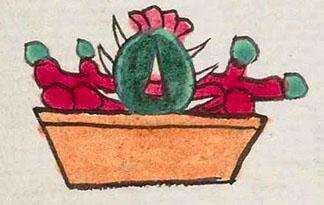nocheztli (Mdz43r)
This simplex glyph for cochineal (nocheztli) also stands for the place name Nocheztlan (or Nochiztlan). It is shown as a container with cochineal insects (red) and one fruit (nochtli) from the prickly pear cactus. In the compound glyph from which this simplex cannot easily be extracted, the red liquid (blood) underlines the reading of nocheztli.
Stephanie Wood
Cochineal is a dye that is derived from an insect that grows on the nopal cactus. The change from the vowel "e" to "i" in the root "nochez" for the place name is not unusual. Perhaps it would be more correct to spell the place name Nocheztlan. The "ez" is from eztli, blood, given how the color of the dye that comes from cochineal is the color of blood. Cochineal was used primarily to dye textiles, but today it is a natural dye that is found in foods, lipstick, and more. The container that holds the cochineal has a shape and a horizontal line similar to the glyph for xicalli (see below, right).
Stephanie Wood
c. 1541, but by 1553 at the latest
red dyes, colorants, insects

nochez(tli), cochineal, https://nahuatl.wired-humanities.org/content/nocheztli
cochineal
la cochinilla, la grana
Stephanie Wood
Codex Mendoza, folio 43 recto, https://digital.bodleian.ox.ac.uk/objects/2fea788e-2aa2-4f08-b6d9-648c00..., image 96 of 188.
The Bodleian Libraries, University of Oxford, hold the original manuscript, the MS. Arch. Selden. A. 1. This image is published here under the UK Creative Commons, “Attribution-NonCommercial-ShareAlike 3.0 License” (CC-BY-NC-SA 3.0).
